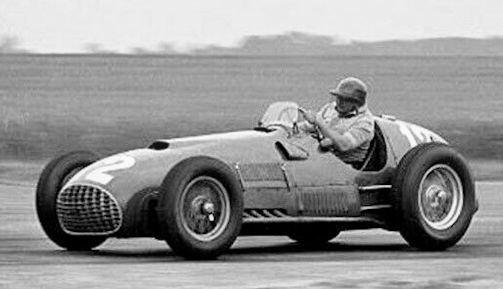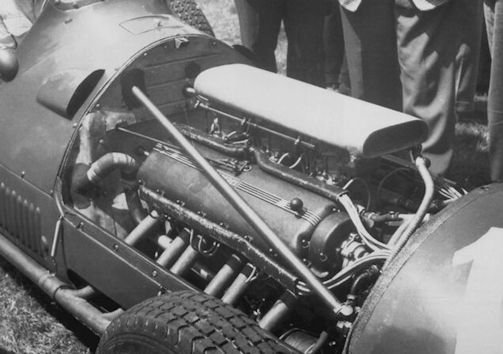Ferrari 375 F1
 |
|
|
Builder |
Ferrari |
|
Class |
Race Car |
|
Category |
Formula 1 |
|
Designed by |
Aurelio Lampredi |
|
Chassis |
tubular spars and crosspieces |
|
Motor |
12-cylinder V -engine4 493 cm³ |
|
Transmission |
4-speed manual gearbox + non-synchronized RM mounted in block with the differential; rear-wheel Drive |
|
Length |
3 937 mm |
|
Length |
1 428 mm |
|
Height |
960 mm |
|
Step |
2 320 mm |
|
Weight |
850kg |
|
Fuel |
Shell |
|
Tyres |
Pirelli |
The Ferrari 375F1 was a Formula 1 - racing cars , built and used by the Scuderia Ferrari in the early 1950s.
History
The Ferrari 375 F1 which Scuderia Ferrari took part in the 1951 Formula 1 world championship . It represented the final stage in the development of the 4,500 cm³ naturally aspirated V12 after the 275 F1 and the 340 F1 .This was responsible for the first victory for Scuderia Ferrari in a race valid for the Formula 1 World Championship by José Froilán González in the 1951 British Grand Prix .
The engines he built for the Ferrari 275F1 , 340F1 and Ferrari 375F1 mirrored this view. The most powerful engine was used in the 375F1. This engine had a maximum of 280 kW (380 hp) at 4.4 Liters. Lampredi was convinced that with this technology, the cars were lighter and easier to drive, the engines would be less strained and by the lower gasoline consumption would be more economical. The chassis and suspension were taken from the Ferrari 340F1. It had double wishbone and transverse leaf spring front and a De Dion suspension with a transverse leaf spring rear.
Proceeding in forced stages, the Ferrari engineers managed to create the new V12 by the end of the 1950 season .4,500 cm³ , maximum displacement allowed by the regulation, based on the experiences gained in the same year with V12s of smaller displacements. Mounted on the 375 F1, it would have allowed the Maranello team to finally compete on an equal footing with the Alfa Romeos. Capable of releasing 330 HP at 7,000 rpm, it would reach 380 HP at 7,500 rpm the following year compared to the 425 of the new Alfetta 159 which had a volumetric compressor but suffered from more than triple the fuel consumption compared to the 375 F1 (2.5 km / l for Ferrari, 0.58 km/l for Alfa Romeo).

In its early outings, the 375 F1 shared everything apart from the engine with the 340 F1 , but just before the start of the 1951 season it underwent major upgrades. As mentioned, by modifying the compression ratio the new engine was brought to 380 HP and was also equipped with a new double ignition with a single magneto now placed at the front (previously it was single with two magnetos). The dimensions of the chassis in both wheelbase and track were revised and new Weber carburettors were adopted . However, the suspension layout and the gearbox remained unchanged with the differential.
In 1952, with the regulatory changes that promoted Formula 2 cars to the rank of Formula 1 , the 375 F1 was prematurely retired but continued to appear in free formula races especially by private drivers. In the same year it was used in the Indianapolis 500 by Alberto Ascari in the Indy version .
The debut of the 375 F1 took place at the 1950 Italian Grand Prix with two cars entrusted to Alberto Ascari and Dorino Serafini . At the first crossing of the finish line Ascari passes second behind Farina's Alfa, lap after lap the leading two make a gap behind him and on the 15th lap Ascari takes the lead but one lap later the Milanese driver is forced to retire due to a bearing broke, thus leaving the way free for Farina to win the race and the world championship. However, a few laps later Ascari took the wheel again aboard Serafini's car, which had stopped for a tire change, and after a frenetic comeback he took second place overall.
The last event of the 1950 season was the Penya Rhin Grand Prix , a race not valid for the world championship. Here Ferrari always showed up with Ascari and Serafini who finished first and second respectively at the wheel of the 375 F1 without the Alfa Romeos to oppose them. In fact, the Milanese company, having acquired the title with Farina, had decided to abandon the last event of the season. Ferrari had therefore not yet managed to directly prevail over Alfa Romeo, but this possibility was no longer remote and would materialize the following year.
In smaller races, the 1951 season got off to a favourable start for the 375 F1 which won in Siracusa and Pau , with Villoresi , and in San Remo with Ascari. In this last race the evolution of the car equipped with 380 HP made its debut. A 375 F1 exhibited in Maranello
The start of the 1951 championship was once again favourable to the Alfa Romeo of Fangio and Farina who won in Switzerland , Belgium and France while Ascari collected a sixth and two second places. But the first victory was now close and came at the British Grand Prix thanks to José Froilán González . The Argentine driver still had the car from the previous year but this didn't seem to affect him and he took pole ahead of Fangio. The race was a monologue between the two Argentine drivers: Felice Bonetto made the best start and remained in the lead for a lap but then had to give way to the faster González and Fangio. On the 10th Lap Fangio takes the lead, but the Argentine's Ferrari remains close to the Alfa Romeo. After 39 laps Gonzalez returns to the lead but Fangio reattacks him and overtakes him. Ascari, who had retired, decided to let González continue given the Argentine's situation. Gonzalez manages to overtake the Argentinian from Alfa, winning the race by 50 seconds, it is Scuderia Ferrari's first victory in Formula 1, and it is the first time that Alfa Romeo does not win. Villoresi finished third, more than two laps behind first two.
The victory in Great Britain was no coincidence, however, and confirmed Ferrari as Alfa Romeo's biggest rival in winning the title. In the following two grand prix Ascari won as many victories ahead of González (3rd and 2nd) and was able to present himself at the Spanish Grand Prix , the last valid event for the world championship, fighting for the title with Fangio. In fact, both need a victory to win the championship. Ascari is in pole position ahead of Fangio, González and Farina. The Milanese driver leads the pack ahead of Gonzalez at the start but at the end of the first lap González is already fifth overtaken by Farina, Fangio and Bonetto. On the fourth lap Fangio passes Farina and Ascari who is suffering from tire problems. The gap from the Argentine increases lap by lap, Ascari pays for the choice of using fewer wide tires compared to previous GPs. Fangio wins the race and the world championship with González second, Farina third and Ascari only fourth.
The end for the 375 as a service vehicle in the World Cup came by a change in the regulations. From 1952, the Grand Prix races were extended with vehicles of Formula 2 and the Scuderia put the Ferrari 500 a. Next ran the 375F1 but in the formula Libre; Ferrari also used there 1952 still factory cars. Three 375F1 were sold to private drivers. The Ferrari 375 Indianapolis was also based on the 375F1 as the thin wall Special .
Technical
-
Ferrari 375 F1 Technical details and specifications (1950-1951)
ENGINE:
12-cylinder V-engine
Bore × stroke: 80 × 74.5 mm
Displacement : 4494 cc
Compression: 11: 1
Motor control: overhead camshaft, chain, 2 valves per cylinder
carburetor: three downdraught four-choke Weber 42 DCF
Cooling: Water (with pump)CAPACITIES:
Fuel tank capacity: 195 litersTRANSMISSION DRIVE LINE:
Transmission: Four-speed, one reverse
multi-plate clutchCHASSIS BODY:
Chassis:Tubular frame, two oval side membersSUSPENSION:
Front suspension: Double wishbone, transverse leaf spring
Rear suspension: De-Dion axis, transverse leaf spring
shocks: Lever shock absorbers front and rearBRAKES:
brakes: Four hydraulically operated drum brakesDIMENSIONS AND WEIGHT:
Wheelbase: 2320 mm
Track: 1278/1250 mm
External dimensions:3937 × 1428 × 960 mm
Dry weight : 720 kg (including water and oil)
